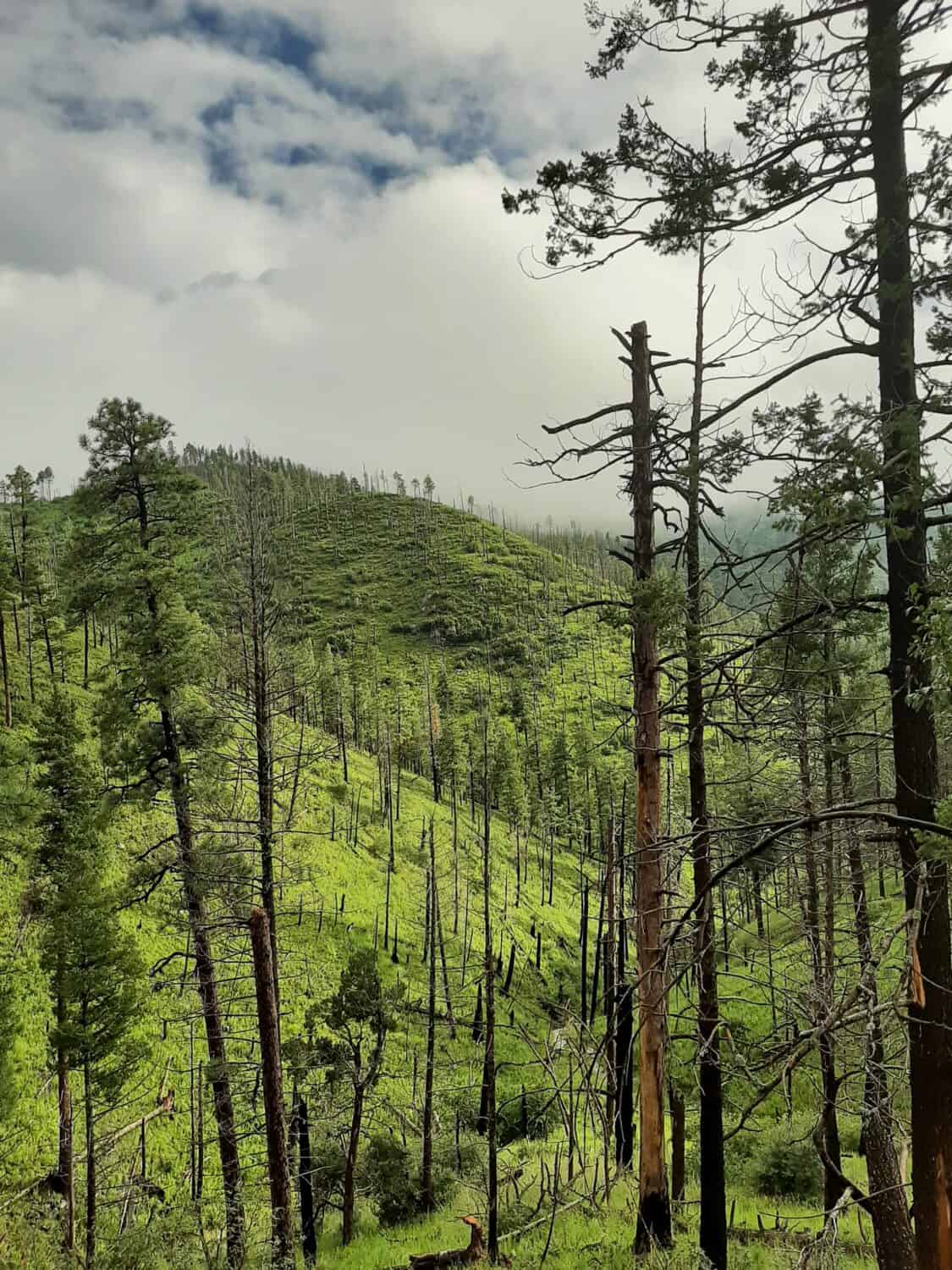By offering different views, perspectives provide contrast in our lives: wet versus dry, close versus far, new versus old, witnessed versus imagined, and changing seasons. Recently, as we hiked along the Black Range Crest Trail, I was reminded constantly of change. When we first arrived in the Kingston area over 15 years ago, the trail was heavily forested and offered stunning views when you reached a pass or treasured opening. The vistas in all directions were automatic pauses in your progress. They were “As good as it gets.”
Then a lightning strike on June 7,, 2013, ignited the Silver Fire. The 2002 drought had set off a very heavy beetle kill of the White Fir that cloaked much of the Sawyer Peak slopes. The deadfall, often three feet deep, that clad those rugged, steep, steep slopes were tinder just waiting for a match. The fire eventually touched over 132,000 acres of forest and much of the southern portion of the Aldo Leopold Wilderness.
When I talk to people who were here for the Silver Fire, the main thing they remember is the evacuation for 11 days. Some recall the backburn that resulted in much of Old Kentuck burning. Others recall seeing how close the fire came to our community, to the very edge, when it tossed cinders down the face of Iron Hill and they ignited the pinyon forest there which roared back up the hill and into itself.
That fire was over nine years ago and yet when I look out over the land surrounding Kingston, the remnants of that event are still very present. Many of the burnt trees remain as snag reminders. What was once a very thick forest of Pinyon Pine is now mainly large shrubs, Mountain Mahogany, Silktassel and oak. The grasses where they have not been heavily grazed, have come back on some of the slopes, but the forbs are the main cover now. Nature is always changing but usually in gradual ways. A forest fire such as the Silver Fire and the recent Black Fire creates a stunningly abrupt change. Lush, green canopies have become a landscape of burnt spires. We experienced the old landscape by hiking through it, tasting its moods as the seasons changed and witnessing the birth and death of everyday life. We became content with those patterns.
But with the sudden alteration of the landscape by a major fire, those familiar patterns changed. It is the new landscape evolving which gives perspective to the old. The contrasts tend to bring clarity to the landscape elements. To those who did not experience the pleasures of the heavily forested Black Range prior to the Silver and now the Black Fire, they can only imagine what once was.
This year was on track to be one of our driest on record. The winter was one of a few dustings of snow, not a wonderland of storms leaving three, four, six or even 18 inch blankets of the white which some of us fondly recall. From memory then, came the perspective of snowy winters, replenishing the mountain forest soils, where snowmelt slowly percolated deep down into the rocky land where it stayed until roots found it later. When walking the woods this past winter, the sense emanating from the land was one of thirst, a hunger for water.
Then news came of the fire burning around Hermit Peak near Las Vegas. Memories again flooded my mind as my wife and I had spent a nourishing ten days, 3 years ago, camping along a big loop of wonderland from Ruidoso and Nogal Peak, Las Vegas and Hermit Peak to Mora, over to Tres Piedras and back south through La Madera and finally the big roads again to finish the trip, home in Kingston.
We had camped one night up on Johnson Mesa looking across a deep canyon towards Hermit Peak. My tent was nestled in the Bristlecone Pines that lined the mesa’s edge. We knew it was going to be a very windy night, so my wife and dogs were smartly cloistered in the Subaru while I tented the night in lee of the car and protection of the ancient Bristlecones.
The 60 mile per hour gusts made the night memorable but one experience stands out, and always will in my memory. At 1 am in the starry night, I was awakened by flashing lights illuminating my tent. They were bright and intense enough to awaken me and cause me to sleepily exclaim, “What the h…..?”
As the pummeling winds pushed and pulled at my tent, I unzipped the opening and clambered out into the night, grasping on tightly to the Bristlecone Pine I had thoughtfully anchored my tent to. My gaze became riveted out to the east in wonder, for over 60 miles away, towering over the east New Mexican plains, was an immense thunderstorm. The night sky was clear and full of Milky Way wonder but there in the far distance, wantonly displaying Nature’s raw power, was a solitary prairie storm.
I watched in awe as the entire thunderhead would light up from lightning within, Nature’s flashbulb on a strobe setting. The pulses of light were intense enough to illuminate my tent. I am still awed by the ability of that storm to emanate such light energy to travel over that distance and wake me from an uneasy slumber. The memory of that night, clinging tightly to the Bristlecone while being buffeted by relentless wind gusts and stunned by the display of nature’s raw power, will always remain with me.
A friend within the US Forest Service, recently told me that the Bristlecone Pines that had once protected the edge of that mesa and gave me an anchor from the winds, are now memories themselves. The Hermit Peak fire burned the mesa and a total of 350,000 acres of wild lands. I think about the experience I would have if I returned to that mesa now. Extreme sadness would reign premier as the memories replayed in my head, but I also consider what the new visitor to the mesa, post Hermit Peak Calf Canyon fire would feel. They would not have the comparison to make, only their current feelings.
While that fire was raging, careless humans started a fire near Black Canyon in the Aldo Leopold Wilderness. That fire would go on the consume 325,000 acres more of some of the wildest, most rugged lands left in the southwest. Between the two largest fires in New Mexico history, some of the most rugged wild land left, will never be experienced as they once were.
Within those burned lands and the lands nearby which were threatened but instead became passage to the wildlife refugees fleeing before the flames, lie many perspectives to be explored and savored. The land prior to the fires this year was a crisp world of brown. The trees were late in leafing out. The leaves on the evergreen shrubs were turning yellow and dropping. It was a world hoping to hold on until the monsoons’ revival.
On June 17th, the first moisture fell. Then the following day, 1.2 inches fell on Kingston and the burning lands to our north. I have written on this rain topic, but it needs more recognition for the transformation it wrought. Today, if a visitor drove Highway 152 up the mountain from Hillsboro, by Kingston and on up to Emory Pass, they would see a world of dripping green. All the creeks running. Threatening clouds building high giving promise of more to fall.
They would not have the memory of the brown, parched lands just two months prior. If they had made that same traverse in May, then their feel of great change would be worthy of long conversations.
My storyline is this: without experiencing the many moods of nature over a period of time, one has read just the first few pages of a novel and feels informed and knowledgeable of the whole story. Not so. It is in the experiencing of nature in all weathers and times of year, that one gains a natural perspective.
When you gaze off at a distant mountain range, what do you see? As you enter the forest cladding its slopes, the experience is totally different. The mountain range has not changed, just your close versus far away perspective.
The freshly burned slopes with ashy soils and towering black snags of once majestic giants are the new. The old exists in the memories of those fortunate enough to have walked amongst a vibrant community before the flames arrived.
I know of people, myself included, who have had amazing experiences, some terrifying, some exhilarating. When someone says, “I can imagine what that must have been like,” they are correct. They can only imagine and in doing so, are unknowingly missing critical pieces, the emotion, the smells, the colors, the sounds, the taste of that experience all molded into a moment you witnessed.
If you visit a place once a year at the same time, you will have different experiences but with little variation. But if you visit all seasons and times of day, early morning, the heat of noon or the middle of the night, you will have a very different perspective. You are experiencing the whole gamut of what a place has to offer in ways of amazement and marvel. Actually, you will never experience the whole gamut, but it is fun and exhilarating to keep going back for more.
Early memories versus the now is akin to old versus new. The more experiences you have, the more perspective you have to compare each step you take in life.
There are so many of these perspective views and I encourage you to enrich your daily life by coming up with a few of your own or by just walking out into nature and accept what wraps its marvelous experiences around you.
Knowledge is gained by experiencing life. Ignorance comes by secluding yourself away from life. Unfortunately, I see and have known an extraordinary number of people who walk through this amazing opportunity called life, with blinders on.
Shed those blinders, enjoy a plate of new perspective and brace yourself for one heck of a ride. Your ticket is good for your lifetime.


this article made me cry
beautifully expressed